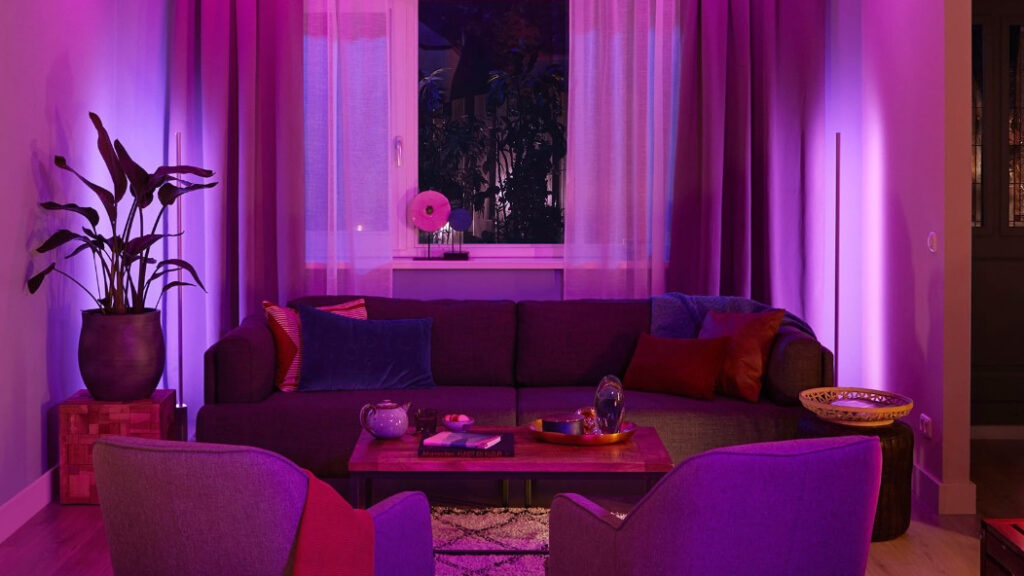
Home office
Rosanna Spence
The best smart lighting brand has an incredible selection. Is it the best buy for you?
If you’ve been thinking about getting some smart light bulbs, you’ve probably seen the Philips Hue brand. Hue was the first iPhone-controlled smart bulb system when it launched back in 2012, and since then it’s become the best-known smart lighting brand.
Hue doesn’t just make smart bulbs. It makes all kinds of smart lighting including flexible lightstrips that you can put behind the TV or under your kitchen cabinets; outdoor spotlights and decorative lights; table, floor and ceiling lights; and all kinds of smart lighting accessories such as motion detectors, dimmers and remotes. All the lights use LEDs, which makes them very energy efficient and therefore cheap to run.
If you’ve been thinking about getting some smart light bulbs, you’ve probably seen the Philips Hue brand. Hue was the first iPhone-controlled smart bulb system when it launched back in 2012, and since then it’s become the best-known smart lighting brand.
Hue doesn’t just make smart bulbs. It makes all kinds of smart lighting including flexible lightstrips that you can put behind the TV or under your kitchen cabinets; outdoor spotlights and decorative lights; table, floor and ceiling lights; and all kinds of smart lighting accessories such as motion detectors, dimmers and remotes. All the lights use LEDs, which makes them very energy efficient and therefore cheap to run.
 Credit: Philips
Credit: PhilipsTo get the most from Hue you’ll need two things: Hue bulbs and a Hue Bridge, which is included in every Hue Starter Pack. The Bridge is a little box that connects to your wireless router and enables you to use all of Hue’s smart lighting features.
The reason you need the Hue Bridge is that unlike some smart lights, Hue lights don’t connect directly to your Wi-Fi. Instead, they use a wireless technology called Zigbee that was designed specifically for smart home devices.
Zigbee keeps your Hue lights separate from your Wi-Fi so you don’t need to worry about your illumination interfering with iPlayer. And each Hue light acts as a network repeater, extending the Zigbee signal to every corner of your home.
You can connect up to 50 Hue bulbs and other items to a single Bridge, and it delivers all the key features including voice control via your smart speaker, automation and even geolocation – so your smart lights can automatically turn themselves on or off when you arrive or leave home.
Hue’s range of smart bulbs covers every conceivable kind of light: screw fittings, bayonet fittings, spotlight fittings and bulbs in sizes ranging from little candle bulbs and GU10 spotlights to large filament-style bulbs and everything in between.
All you need to do is find the right size of bulb for your light fitting, fit the bulb and then connect it via the Hue app.
The only room you can’t use a Hue bulb in is the bathroom, as the bulbs aren’t suitable for bathroom use. Hue does make some bathroom-friendly light fittings but they’re quite expensive: for example the water-resistant, IP44-rated Hue Adore ceiling light is £189.
 Credit: Philips
Credit: PhilipsThis is hands-down our favourite feature of Hue bulbs: being able to control specific lights, whole rooms or our entire home with voice commands is very convenient, and it’s great for people with mobility issues too.
Hue lights and bulbs are compatible with all the leading smart home brands including Google, Apple, Amazon and Samsung, so you can control them with Google Assistant, Siri, Alexa or Bixby – provided you have a Hue Bridge or a Zigbee hub such as the most recent Amazon Echo. More of that in a moment.
Hue has the widest selection of outdoor lights of any smart lighting brand. Hue’s LowVolt range is designed to withstand all kinds of weather, and it features a range of spotlights, bollards and pedestal lights starting at around £89, lightstrips at £109 and Amarant lights to wash entire walls with light for £149.
You’ll need a dedicated Hue outdoor power supply and the first outdoor light needs to be within 50 feet of one of your indoor Hue bulbs or the Hue Bridge.
 Credit: Philips
Credit: PhilipsAt the time of writing a Hue Starter Kit with two white bulbs is £47, and one with three colour-changing bulbs is £169. However, you can get Hue bulbs for a lot less if you buy the ones marked as Bluetooth compatible.
Buying a pair of Hue Bluetooth bulbs is about £25 compared to the £47 for the same bulbs with a Bridge. But there are some important differences in what they can do when they’re only connected via Bluetooth.
You can’t connect as many bulbs, you can’t use their advanced features and with the exception of Amazon’s Alexa, you can’t control them from your smart speaker.
If you don’t need colour-changing bulbs or advanced features, one of the cheapest alternatives is IKEA’s Tradfri. Its Starter Kits begin at just £16 for a bridge and one smart bulb.
If you do want colour-changing, TP-Link’s smart bulbs connect directly to your Wi-Fi and start at around £25 for two bulbs.
There are even cheaper colour-changing options that use a little remote control rather than connecting to your Wi-Fi network, but they tend to be very limited in what they can do and aren’t controllable via your phone, tablet or smart speaker. As a result we wouldn’t consider them smart bulbs.
If you want to keep your options open, you could start with one or two Hue Bluetooth bulbs. If you like what your Hues do then it’s just a matter of buying a Hue Starter Kit to get the Hue Bridge and some more bulbs to upgrade your smart lighting system.
 Credit: Philips
Credit: PhilipsIt’s possible to sync Hue smart lights with your TV, DVD player or games console, but it isn’t cheap: in addition to the bulbs, lights or light strips that you want to synchronise with the on-screen action you’ll also need the Hue Play HDMI Sync box, which is currently £229.
You should be able to use any Zigbee bulbs with a Hue Bridge, so for example you can add an IKEA Tradfri bulb or an Innr bulb to a Hue system as both firms use Zigbee too.
However, you can’t always get the same bulbs from rival brands as you can with Hue. For example if you want GU10 bulbs for your kitchen downlighters you’ll probably have to buy Hue ones.
You can also connect Hue lights to other firms’ Zigbee hubs. Amazon’s most recent Alexa devices – the fourth generation Echo, the Echo Show 10 and the Eero 6 Wi-Fi routers – have built-in Zigbee hubs, and the Aeotec Smart Home Hub for Samsung’s SmartThings system is a Zigbee hub too.
In practice, we’ve found connecting different firms’ bulbs to a Hue system a little more unpredictable and fiddly than it should be.
However from this year onwards, Hue and all the other big smart home names are going to support Matter, a new smart home standard designed to make all kinds of devices work happily with one another.

Written by Carrie Marshall she/her
Published: Updated:
Writer, broadcaster and musician Carrie Marshall has been a technology journalist for 24 years. Her CV is a who’s-who of magazines, websites and newspapers ranging from T3, Techradar and Woman & Home to the Sunday Post and People’s Friend, and she has been providing no-nonsense technology help and buying advice to BBC Radio Scotland listeners since the early 2000s.
Carrie has written and co-written nearly twenty books as well as a BBC radio documentary series, and her memoir Carrie Kills A Man is on sale now.
Carrie is particularly interested in how technology can make our lives easier, especially if that gives her an excuse to buy yet another kitchen gadget.